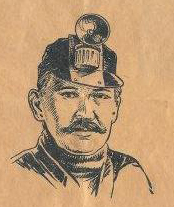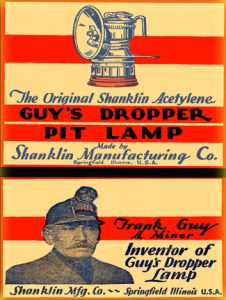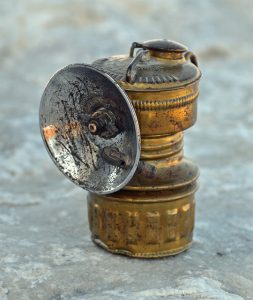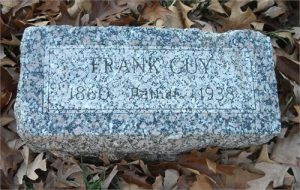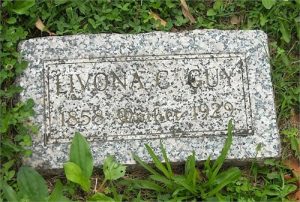20 April 1858 – 9 January 1930
Livona Cordelia Claybourn (“Aunt Vone”) was born on 20 April 1858 in Jefferson County, Illinois. On 3 July 1887 she married Frank Guy.[Frank Guy was born on 9 April 1860 to Charles E. Guy (b. 1827) and Mary A. Landis (b. 1837). They were married in 1859. Frank spent his youth in Lawrence County, Illinois, near the Wabash River. By 1870 Frank’s family had moved across the river into Indiana where Frank’s father farmed in Spice Valley. A decade later, Frank (then twenty-years-old) was working as a coal miner in nearby Washington, Indiana.] The couple started their family in Athens, Illinois (about ten miles north of Springfield), and had three children. In 1905 they moved to Springfield, where they would live at 2201 Eleventh Street for the remainder of their lives.[Dave Thorpe, Beneath the Surface: Inventors and Marketeers of the Miners’ Carbide Light (Bergamot Books, 2010), 81.]
When the family arrived in Springfield, carbide lamps were beginning to be used in mines, and the next year in 1906 Frank saw potential to make improvements.[“Carbid” is the spelling used in early literature. The carbide lamps (or acetylene gas lamps) produce and burn acetylene which is created by the reaction of calcium carbide with water.] By 1908 he had made a version with an improved water dropper. On 1 March 1911 he filed a patent application for the invention and about three years later he received the patent.[Richard C. Finch, “Notes on the History of the Guy’s Dropper Miner’s Lamp,” Speleonews, February 1976, 10.] His complex design included not only a water valve destined to become famous as the patented “Dropper” mechanism, but numerous other novel features.
Others quickly learned of Frank’s lamp which was “a good deal different and a good deal better” than others.[Guy v. Stein, 239 F. 731 (7th Cir. 1916).] A pair of brothers, George and Edgar Shanklin, took notice and proposed a plan to manufacture the new lamp. Under the agreement with Shanklin Manufacturing Co., Frank would receive a royalty of $100 per month for the use of his name and patented dropper.[Thorpe, Beneath the Surface, 83.] The lamps were known across the world as “Guy’s Droppers” (or just “Droppers”).
Business with the new lamp boomed. Due to World War I, coal consumption increased enormously and the demand for Guy’s Droppers continued well after the war. Shanklin’s peak production year was 1919, when 720,000 lamps were turned out.[Finch, “Notes on the History of the Guy’s Dropper Miner’s Lamp,” 11.] Eventually the Shanklin brothers quarreled and a Mr. Theodore Hoffacker bought control of the company. Poor management and the Great Depression doomed the company and by July 1932 it was bankrupt and in receivership.
However, Guy’s Doppers remained popular across the globe, so Universal Lamp Co. of Chicago bought Shanklin’s interests and continued the production of Guy’s Droppers, though with somewhat less variety than before.[Finch, “Notes on the History of the Guy’s Dropper Miner’s Lamp,” 12.] By 1960 the lamps had been phased out in favor of newer battery operated lamps. Nevertheless, Frank’s ingenious mechanisms continued in other products, including as a brass whiskey pump.
Guy’s Droppers were produced well into the millions and it was the favorite lamp for tens of thousands of coal miners and countless spelunkers and midnight fisherman. It was one of the most popular lamps in history for mining and underground exploration. Sadly, despite this popularity and the resulting royalties, Frank and Livona fell on hard times due to the Great Depression.
Today vintage forms of Guy’s Droppers have become valuable among antique collectors. And despite more modern electric and battery-powered choices, a substantial percentage of caving and mining enthusiasts still use Guy’s Droppers due in part to their quality and warmth.[Guy’s Droppers were so popular, in fact, that Safesport Manufacturing began producing a “Butterfly lamp” as a direct copy of the Guy Dropper design. Butterflys were manufactured in the late 1970s and throughout the 1980s in Hong Kong, targeted to campers, hunters, and cavers. However, this imitation was of very poor quality and performed nothing like the true Guy’s Droppers.] Livona died on 9 January 1930.[Death Certificate of Livona Cordelia Guy, Illinois State Archives (Springfield, Illinois), No. 2840032, Sangamon County, died 9 January 1930.] Frank died some years later of pneumonia on 11 February 1938. They are both buried in Oak Ridge Cemetery in Sangamon County, Illinois.
Descendants
- Fred Guy was born on 2 July 1889. He worked as a coal miner in Springfield, Illinois, with Sangamon Coal Company. Fred was a tall, slender man with blue eyes and light brown hair. He entered military service in 1917, but was dishonorably discharged for being AWOL.[Thorpe, Beneath the Surface, 86.] He married Estella Maude Anderson (“Stella”) in late 1909 or very early 1910.[Estella Anderson was born on 4 March 1886 in Illinois.] They had eight children in Springfield, Illinois, including twin girls who died shortly after birth, then moved to San Luis Obispo County, California, in about 1924 and had two more children there. After the move Fred worked as a brakeman for the railroad. Estella died on 3 December 1957. Fred died on 10 May 1965 and is buried in Arroyo Grande, California. They are both buried together in Arroyo Grande Cemetery in San Luis Obispo County, California.
- Gladys Loretta Mae Guy was born on 8 October 1910 in Springfield, Illinois. She married Victor Danieli (1912-1957) after 1940 and prior to 1956, when they are living in Redwood City, California. He died there the next year and is buried with his Italian-born parents in Guadalupe Cemetery in San Mateo County, California. There are no California birth records for children from their marriage. Gladys died on 16 August 1981 in Santa Clara County, California, and is buried in Arroyo Grande Cemetery with her parents.
- An unnamed infant Guy (twin girl) was born on 30 January 1913 in Springfield, Illinois, and died on 2 February 1913.
- Wuneada Guy (twin girl) was born on 30 January 1913 in Springfield, Illinois, and died on 11 February 1913. The twins are buried together in Oak Ridge Cemetery in Sangamon County, Illinois.
- Helen Ida Guy was born on 27 September 1914 in Springfield, Illinois. She died on 11 October 1934 in San Luis Obispo County, California, and is buried in Arroyo Grande Cemetery with her parents.
- Charles Fredrick Guy was born on 21 May 1916 in Springfield, Illinois. He did not marry and lived near his parents until their deaths. He then moved to San Jose, Santa Clara County, California, where he died on 27 August 1986. He is buried in Arroyo Grande Cemetery with his parents.
- William Archie Guy was born on 25 March 1918 in Springfield, Illinois. He did not marry and remained in San Luis Obispo County, California, working as a driver until his death there on 18 June 1985. He is buried in Arroyo Grande Cemetery with his parents.
- Catherine Marie Guy was born on 14 July 1921 in Springfield, Illinois. She did not marry and worked as a waitress, hotel maid, hospital housekeeper, and warehouse person at DelMonte Cannery. She died on 22 December 1991 in San Joaquin County, California, and is buried in Arroyo Grande Cemetery with her parents.
- Etta Guy was born about 1923 in Springfield, Illinois. She lived with her parents in San Luis Obispo County, California, in the 1930 and 1940 census and the 1942 city directory. In about 1945, Etta L. Guy married Robert Martin Rische (1923-2007), a World War II veteran from Fresno County, California. They had two children together, then divorced in about 1961. He married again in 1963 to May L. Christian Kole. On 12 April 1969 in Santa Cruz County, California, Etta married Constante Lombardini (1919-1991), who had divorced his first wife in 1967. He is buried in Los Osos Valley Memorial Park Cemetery in San Luis Obispo County, California. Thereafter Etta lived in the Arroyo Grande area.
- Robert Martin Rische Jr. was born in 1946 in Fresno County, California. On 5 February 1983 in Madera County, California, he married Barbara L. Masseti. They had three sons.
- Robert Martin Rische was born in 1986.
- Thomas Phillip Rische was born in 1987.
- David Guy Rische was born in 1991.
- Barbara Marie Rische was born in 1947 in Fresno County, California. On 16 September 1967 in Fresno County, California, she married Robert G. Ross, but they divorced in April 1969 in Santa Cruz County, California. She was married to Mr. Hersh at the time of her father’s death in 2007.
- Robert Martin Rische Jr. was born in 1946 in Fresno County, California. On 5 February 1983 in Madera County, California, he married Barbara L. Masseti. They had three sons.
- Alice Livona Guy was born on 19 March 1925 in San Luis Obispo County, California. She is listed with her parents there in the 1930 and 1940 census, but not afterwards.
- Alberta Mae Guy was born on 12 June 1929 in San Luis Obispo County, California. She lived with her family in Stockton, California, usually with no occupation listed. In about 1981 she married Mr. Paez. Alberta died on 1 January 1995 in San Joaquin County, California, and is buried in Arroyo Grande Cemetery with her parents.
- Archibald Guy (“Archie”) was born on 25 February 1891 in Athens, Illinois. He was not given a middle name. As a teenager he produced a daughter, Dorothy, while living at home.[This daughter was born to Archie and Leta F. Werts (1893-1969). Leta married Orville Beams (1892-1918) in 1914 and they moved to Detroit. In about 1925 she married Michael Barrett there and spent the rest of her life in Michigan.] She was raised by Archie’s parents, who were now in their fifties, while Archie worked for the Paige Motor Company in Detroit, Michigan. In 1917 Archie moved to San Francisco, California, and then married Lolita Louise Eicher in 1919, and they settled in Napa, where he managed a branch of E.C. Kroft and Co., an automobile parts supplier.[Lolita Eicher was born on 22 November 1895 in Contra Costa County, California. She died on 13 April 1993.] Together they had one son, Robert. On his World War II registration card in 1942 Archie indicated he was working for E.C. Kraft at Santa Rosa, California, and living not far away in Petaluma. It is not clear that he ever served in the military. Some evidence suggests that he married a third time and had another child with this wife.[Verner M. Claybourn and Harriette Pinnell Threlkeld. The Claybourn Family (A-1 Business Service, 1959).] Archie died on 21 May 1970 in Napa County, California. Lolita died years later on 13 April 1993.
- Dorothy Marie Guy was born on 15 July 1910 in Springfield, Illinois, to Archie Guy and Leta F. Werts, but was raised there by her grandparents Frank and Livona. In about 1927 she married Anthony Francis Kuznik Jr., who was a pattern maker for woodworking shops.[Anthony Kuznik was born on 19 February 2005.] They lived in her grandfather’s
house while having four children. They were still in the house as of the 1940 census, but moved to Vallejo, Solano Co, CA the next year and lived there at least through 1993. They both died in El Sobrante, Contra Costa County, California, Dorothy on 16 May 2004 and Anthony on 19 February 2005.- Frances Marie Kuznik was born on 9 April 1929 in Springfield, Illinois. She married Kenneth C. Stanton (1924-2015) on 8 June 1952 in Solano County, California. They had two children. She died on 6 November 2011 in Alameda County, California. She and her husband are buried in Sunset View Cemetery in Contra Costa County, California.
- Raymond Charles Stanton was born on 4 August 1956 in San Francisco, California, and died there on 29 January 1993. He married Marcella Rosa Squadrito on 8 August 1988 in Douglas County, Nevada. They probably did not have children.
- Shari Stanton was born in 1958 in Contra Costa County, California. She married Fred P. Rodrigues there in 1981 and they had a son and a daughter.
- William Robert Kuznik (“Bill”) was born on 14 March 1931 in Springfield, Illinois. He served in the U.S. Marine Corps in the Korean War from July 1950 to January 1952. He married his high school sweetheart Erma Lee on 25 October 1952 and they had three children. Bill worked at the Benicia Arsenal, and later was hired by Pacific Telephone & Telegraph. He retired from AT&T in 1985 as an installer/repairman. He then worked for UCD Physical Plant as an electrician from 1985-1992. Golfing, fishing, hunting, camping, and traveling were the highlights of Bill’s life. He died on 7 March 2015 in Woodland, Yolo County, California, and is buried in Sacramento Valley National Cemetery.
- Virginia Ann Kuznik was born on 7 November 1932 in Springfield, Illinois. In about 1953 she married Mr. Harrison, with whom she had a son. In about 1960 she married Mr. Robarts. In about 1981 she married Mr. Winther. She died on 26 December 1990 in Contra Costa County, California.
- Mark Alan Harrison was born in 1955 in Solano County, California.
- Raymond G. Kuznik was born on 19 February 1936 in Springfield, Illinois, and died there on 28 February 1938 of pneumonia. He is buried in Oak Ridge Cemetery in Sangamon County, Illinois.
- Frances Marie Kuznik was born on 9 April 1929 in Springfield, Illinois. She married Kenneth C. Stanton (1924-2015) on 8 June 1952 in Solano County, California. They had two children. She died on 6 November 2011 in Alameda County, California. She and her husband are buried in Sunset View Cemetery in Contra Costa County, California.
- Robert H. Guy was born on 30 September 1921 in San Francisco, California. While a resident of Sonoma County, California, he enlisted in the U.S. Army on 26 February 1943. While serving as a private first class in the 275th Infantry Division, he died on 17 April 1945 in Europe, probably inside Germany. His remains were buried on 18 April 1949 in Golden Gate National Cemetery in San Mateo County, California.
- Dorothy Marie Guy was born on 15 July 1910 in Springfield, Illinois, to Archie Guy and Leta F. Werts, but was raised there by her grandparents Frank and Livona. In about 1927 she married Anthony Francis Kuznik Jr., who was a pattern maker for woodworking shops.[Anthony Kuznik was born on 19 February 2005.] They lived in her grandfather’s
References and Notes



